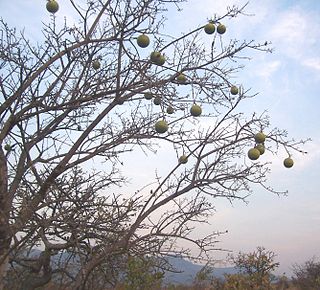Related Research Articles

Capparis spinosa, the caper bush, also called Flinders rose, is a perennial plant that bears rounded, fleshy leaves and large white to pinkish-white flowers.

Prunus spinosa, called blackthorn or sloe, is a species of flowering plant in the rose family Rosaceae. It is native to Europe, western Asia, and locally in northwest Africa. It is also locally naturalized in New Zealand, Tasmania and eastern North America.

Aralia spinosa, commonly known as devil's walking stick, is a woody species of plant in the genus Aralia, family Araliaceae, native to eastern North America. The various names refer to the viciously sharp, spiny stems, petioles, and even leaf midribs. It has also been known as Angelica-tree.

The spiny turtle is a South-East Asian turtle species. It inhabits lowland and hill rainforest, usually in the vicinity of small streams, mainly in hill areas up to 900 m above sea level.

Ononis spinosa is a plant belonging to the family Fabaceae, that is commonly known as spiny restharrow or just restharrow. It is found throughout much of Europe including Britain, but seldom as far north as Scotland.
In the geologic timescale, the Asselian is the earliest geochronologic age or lowermost chronostratigraphic stage of the Permian. It is a subdivision of the Cisuralian epoch or series. The Asselian lasted between 298.9 and 295 million years ago (Ma). It was preceded by the Gzhelian and followed by the Sakmarian.

Tara spinosa, commonly known as tara (Quechua), is a small leguminous tree or thorny shrub native to Peru. T. spinosa is cultivated as a source of tannins based on a galloylated quinic acid structure. This chemical structure has been confirmed also by LC-MS. It is also grown as an ornamental plant because of its large colorful flowers and pods.

Strychnos spinosa, the Natal orange, is a tree indigenous to tropical and subtropical Africa. It produces, sweet-sour, yellow fruits, containing numerous hard brown seeds. Greenish-white flowers grow in dense heads at the ends of branches. The fruits tend to appear only after good rains. It is related to the deadly Strychnos nux-vomica, which contains strychnine. The smooth, hard fruit are large and green, ripen to yellow colour. Inside the fruit are tightly packed seeds, which may be toxic, surrounded by a fleshy, brown, edible covering. Animals such as baboon, monkeys, bushpig, nyala and eland eat the fruit. The leaves are a popular food source for browsers such as duiker, kudu, impala, steenbok, nyala and elephant.
Malikia is a genus of Gram-negative bacteria.

Quasipaa spinosa is a species of frog in the family Dicroglossidae. It is known under many common names, including Chinese spiny frog, giant spiny frog, Chinese edible frog, and spiny paa frog. Its names refer to the distinctive characteristics of the species, relatively large size and the spiny chest of male frogs. Giant in frog terms only, it can nevertheless grow to lengths above 10 cm (4 in); this makes it the largest frog in Hong Kong.

Capparis is a flowering plant genus in the family Capparaceae which is included in the Brassicaceae in the unrevised APG II system. These plants are shrubs or lianas and are collectively known as caper shrubs or caperbushes. Capparis species occur over a wide range of habitat in the subtropical and tropical zones.

Bursaria spinosa is a small tree or shrub in the family Pittosporaceae. The species occurs mainly in the eastern and southern half of Australia and not in Western Australia and the Northern Territory. Reaching 10 m (35 ft) high, it bears fragrant white flowers at any time of year but particularly in summer. A common understorey shrub of eucalyptus woodland, it colonises disturbed areas and fallow farmland. It is an important food plant for several species of butterflies and moths, particularly those of the genus Paralucia, and native bees.

Grayia spinosa is a species of the genus Grayia in the subfamily Chenopodioideae of the flowering plant family Amaranthaceae, which is known by the common names hop sage and spiny hop sage. It is widely distributed across the Western United States, where it grows in a number of desert and mountain habitats.
M. spinosa may refer to:

Cephonodes hylas, the coffee bee hawkmoth, pellucid hawk moth or coffee clearwing, is a moth of the family Sphingidae. The species was first described by Carl Linnaeus in 1771. A widely distributed moth, it is found in the Near East, Middle East, Africa, India, Sri Lanka, Japan, Southeast Asia and Australia.

Eupalitin is an O-methylated flavonol. It can be found in Ipomopsis aggregata.
Jensenia spinosa is a dioicous bryophyte plant in the liverwort family Pallaviciniaceae. It is the only African member of the genus Jensenia, and generally occurs at high elevations. It is widespread but scarce, and has been found in South Africa, Malawi, Tanzania, Rwanda, the Democratic Republic of the Congo, as well as the islands of Mauritius, Réunion and Saint Helena.
Malikia granosa is a Gram-negative, rod-shaped, motile bacterium with one to two polar flagella from the new genus Malikia in family Comamonadaceae. It was isolated from activated sludge of a municipal wastewater treatment plant. Colonies of M. granosa are creamy–white in color.

Macromonasbipunctata is a Gram-negative, colorless, and heterotrophic sulfur bacterium of the genus Macromonas. It is commonly found in sewage aeration tanks and caves where moonmilk has formed. In the 1920s, researcher Gicklhorn first discovered this organism under the name Pseudomonasbipunctata. After further study and culturing by Utermöhl and Koppe, in 1923, it was later renamed Macromonasbipunctata. This organism is thought to be non-pathogenic species. In fact, the moonmilk produced was referenced as a remedy for infections in the Middle Ages.
Grevillea spinosa, also known as the spiny grevillea, is an evergreen shrub of the genus Grevillea native to an area in the east of the Mid West, northern Goldfields-Esperance and southern Pilbara regions of Western Australia.